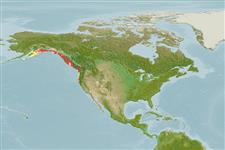Common names from other countries
Classification / Names / Names
आम नाम | उपशब्द | Catalog of Fishes (gen., sp.) | ITIS | CoL | WoRMS
Environment: milieu / climate zone / depth range / distribution range
पारिस्थितिकी
; गहराई सीमा 0 - 125 m (Ref. 95072). Temperate; 71°N - 32°N, 141°E - 117°W
Arctic and Northern Pacific.
Length at first maturity / आकार / वज़न / Age
Maturity: Lm ?, range 4 - 5 cm Max length : 19.0 cm WD पुल्लिंग / अलिंग; (Ref. 128652); अधिकतम सूचित उम्र: 200 वर्षो (Ref. 128652)
Harvestable size is around 9-10 cm test diameter (4-5 years in age) (Ref. 121955). Found in relatively high energy environments on open rocky intertidal and subtidal shores (Ref. 121802). Herbivorous grazer in nearshore habitats (Ref. 121801). Kelp forest species (Ref. 121804). Found in concentrated amount at the apex of the holdfast of the giant kelp Macrocystis pyrifera (Ref. 121803).
Members of the class Echinoidea are gonochoric. Fertilization is external. Brooding is common, eggs are held either on the peristome, around the periproct or deep into the concavities on the petaloids. Life cycle: Embryos develop into planktotrophic larvae (echinoplateus) and live for several months before they sink to the bottom using their tube feet to adhere on the ground where they metamorphose into young urchins.
Bisby, F.A., M.A. Ruggiero, K.L. Wilson, M. Cachuela-Palacio, S.W. Kimani, Y.R. Roskov, A. Soulier-Perkins and J. van Hertum. 2005. (Ref. 19)
IUCN Red List Status (Ref. 130435)
CITES status (Ref. 108899)
Not Evaluated
Not Evaluated
Human uses
मात्स्यिकी: व्यापारिक
| FishSource |
साधन
इंटरनेट स्रोत
Estimates based on models
Preferred temperature
(Ref.
115969): 4.1 - 10.7, mean 8.6 (based on 90 cells).
लौटाव
निम्न, न्यूनतम जनसंख्या दुगनी होने का समय 4.5 - 14 वर्ष। (K=0.08).
